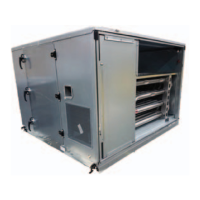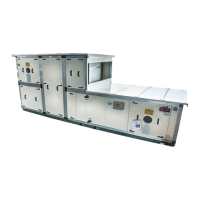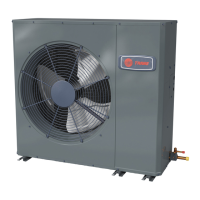Component Installation Requirements
CLCH-SVX010A-EN 35
Fan Discharge Connections
To ensure the highest fan efficiency, duct turns and
transitions must be made carefully, minimizing air friction
losses and turbulence. Proper ductwork installation, as
outlined by such organizations as Sheet Metal and Air
Conditioning Contractors National Association, Inc.
(SMACNA), should be followed closely.
Indoor unit fan sections with rectangular or round
openings should have flanged ductwork attached to
bottom panel opening. When using lined ducts, the
insulation should not obstruct the discharge opening. For
plenum fan sections with bell mouth fittings, see “Bell
Mouth Discharge Connections” on page 36.
Connections made directly to the discharge opening of a
housed fan should have a minimum of three fan diameters
of straight duct before any turns or transitions. The
ductwork should be the same size as the fan discharge
opening. The first turn of the connection should be in the
same direction as the fan rotation as shown in Figure 41.
The air that the fan discharges into the duct is extremely
turbulent and requires some length of duct to stabilize.
Abrupt changes in ductwork directly off the fan discharge
may adversely affect fan performance and acoustics.
Damper Connections
Standard damper sections include mixing sections, filter
mixing sections, face dampers sections, internal face-and-
bypass sections, and economizer sections. There are two
damper blade configurations available - parallel-blade and
opposed-blade. Traq™ dampers are another type of
damper available in mixing box sections.
Ductwork attached to the standard damper sections
should be sized to fit the opening of the damper. Duct
opening dimensions are provided in the submittals. When
using lined duct, ensure that the insulation does not
obstruct the damper opening (see Figure 42 and
Figure 43).
Note: Damper blades should be checked for proper
operation from full-open to full-closed position
before unit start up. Damper blade positioning may
have changed due to shipping and handling
vibrations.
Discharge Plenum Connections
Discharge plenum sections are available with or without
openings. Sections with rectangular and round openings
Figure 41. Typical discharge ductwork
recommendations
Splitters or
turning vanes
Vane turns in same
direction as fan rotation
3 fan
diameter
minimum
Figure 42. Typical section with duct flat/flange
connection - uninsulated or externally
insulated
Figure 43. Typical section with duct flat/flange
connection - internally insulated
Unit
section
Flat connection
Uninsulated duct
Airflow
Unit
section
Flat connection
Insulated duct
Airflow

